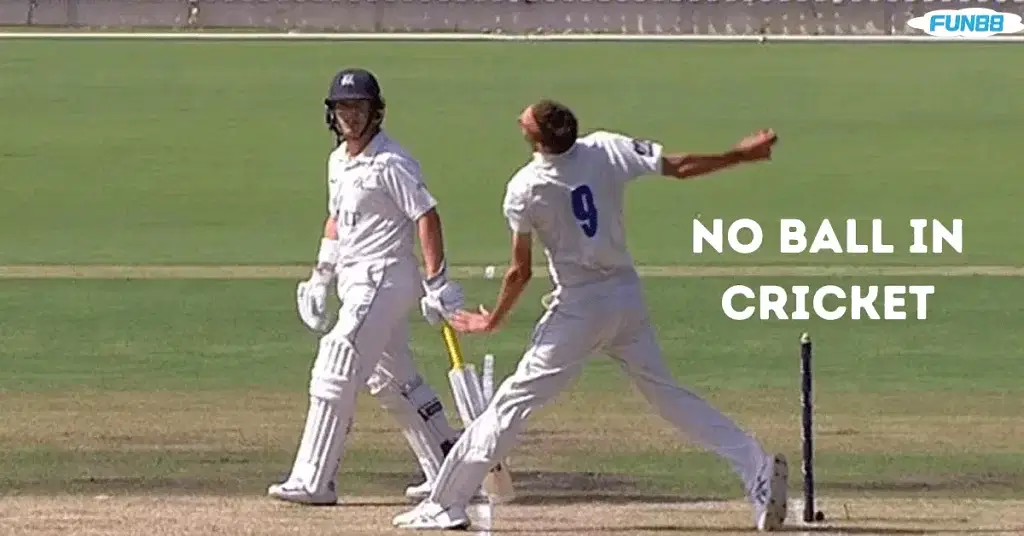Cricket is one of the most popular sports across the world. Especially in India, it is the most loved sport. However, to enjoy the game to the fullest, knowing the cricket rules is important. Among the regulations that shape matches, understanding what constitutes a no ball in cricket is key to determining game outcomes. This detailed guide sheds light on all types of no balls in cricket shedding light on when they are called and how they influence gameplay.
Here, we will go through different types of no ball in cricket to have a better understanding of the game.
Violations Related to Mode of Delivery
According to the laws, bowlers must inform the umpire about their intended mode and side of delivery—whether it’s right-handed or left-handed over or round the wicket. Failure to communicate changes in delivery style results in a no ball being called. If the bowler changes delivery hand without informing the umpire, it may cost him a penalty in the form of a no-ball.
Rules Governing Fair Deliveries: The Arm
An essential element of a cricket delivery is the arm’s movement. To ensure delivery, the ball mustn’t be thrown by the bowler. The cricket laws clearly outline what qualifies as a delivery, with regards to the arm specifically focusing on maintaining the elbow joints position without straightening during the bowling action. This regulation highlights crickets’ commitment to play. Preventing any unfair advantages resulting from illegal bowling techniques.
Prohibition of Thrown or Underarm Deliveries
Cricket regulations strongly oppose thrown or underarm deliveries. If an umpire determines that a bowler has thrown or delivered the ball underarm without agreement immediate actions are taken, such as declaring a no ball issuing warnings and potentially suspending the bowler from bowling in that innings for repeat offenses. These measures demonstrate cricket’s stance against any form of play.
Related Read: A Comprehensive Guide to Cricket Fielding Positions
The Bowler’s Behavior Before Delivery
Interestingly the laws also cover situations where a bowler throws the ball, towards the striker’s end before beginning their delivery stride. While this action may not result in a no ball being called it prompts the umpire to declare and signal a ball to ensure that all play adheres to the game’s spirit and principles.
Fair Delivery
The positioning of the bowlers’ feet while delivering the ball is crucial, for a play. Rules outline requirements for both the foot and front foot to ensure bowlers don’t gain an unfair advantage by stepping outside permitted areas. This attention to detail in the rules aims to keep the competition fair.
Another important rule involves bowlers accidentally breaking the wicket during delivery resulting in a no-ball call unless specific exceptions apply as per the rules. This rule is essential for upholding the integrity of the delivery process.
Instances where deliveries bounce more than once stay along the ground. Pitch-off targets before reaching the popping crease are immediately deemed no balls to give batters a chance at playing. These regulations maintain fairness and balance in the game.
Cricket laws also address situations, like a ball halting in front of a striker’s wicket or a fielder stopping it before it reaches the striker, promptly declaring them as no balls. These examples highlight how comprehensively these laws work to ensure fairness.
Height Regulations on Deliveries
When a bowler bowls a ball that goes over or could have gone over the batter’s head height after bouncing it is classified as a no ball. This regulation serves purposes:
● Safety First: The main rationale behind this regulation is to ensure the safety of the batter. Balls bowled at heights can be erratic and risky making it challenging for the batter to react appropriately and increasing the likelihood of injury.
● Maintaining Fairness: Additionally, this guideline upholds fairness in the game. It prevents bowlers from resorting to deliveries as a strategy, which could otherwise disrupt the equilibrium between the bowling and batting sides.
No Ball for Violations of Rules
A no ball in cricket can also be declared for rule violations aside from commonly known foot faults and arm actions. These infractions include:
● Fielder Positions: Certain fielding positions are prohibited during delivery, like having players than allowed on one side of the field, which can result in a no ball being called.
● Dangerous Bowling: Deliveries deemed dangerous or unfair such as beamers (balls delivered without bouncing and reaching head height) also lead to a no ball being awarded.
These guidelines ensure that all aspects of gameplay adhere to the principles of fairness and safety creating a playing field for all involved.
Reversing a No Ball Decision
There can be scenarios where an umpire’s declaration of a no ball can be reversed. This flexibility allows for rectifying decisions based on information or circumstances:
● Interpretation Error: If the umpire recognises an error in calling a no ball due to misinterpreting the bowler’s actions or player positions they have the authority to change their decision.
● Dead Ball Scenarios: If a dead ball is declared immediately after a no ball call for any reason the initial no ball decision can be retracted.
This capability to reverse decisions promotes accuracy and fairness in umpiring by enabling corrections and upholding the game’s integrity.
Differentiating Between No Ball and Wide Ball
Understanding the distinction between a no ball and a wide ball is crucial in comprehending cricket regulations.
● Definition variations: A no ball primarily pertains to the legality of the delivery itself such as foot faults or unauthorised actions. In contrast, a wide ball is signalled for deliveries that are beyond the batter’s range, preventing them from executing a cricket shot.
● Hierarchy of Calls: If the delivery falls in both, the wide and no ball category, priority is given to no ball, in enforcing penalties and awarding runs.
Impact of No Balls
No balls have consequences and effects on the game such as:
● Additional Runs: The batting team receives extra runs, usually one but this may vary depending on the game format or competition regulations.
● Free Hit Opportunity: In limited overs cricket a no ball often leads to a hit for the delivery offering the batter an opportunity to score without facing the risk of getting out through most dismissal methods.
Also Read: Cricket Match Rules and Scoring: Understand the Basic Law
Scoring System and Penalties for No Balls
Runs obtained from a no ball are recorded as extras for the same with guidelines on accounting for runs scored during that delivery. This detailed scoring mechanism ensures transparency and fairness in determining the game’s outcome.
Exceptions to Dismissals Resulting from No Balls
Despite being called as a no ball there are scenarios where a batter can still be dismissed, such as obstructing the field or getting run out. These special cases ensure that the game stays exciting and just in certain circumstances.
Final Remarks
No balls play a role, in cricket influencing tactics, results and the game tempo. By grasping the kinds of no balls and their consequences, players, officials and enthusiasts can delve deeper into the sport’s complexities.
Star it if you find it helpful.

